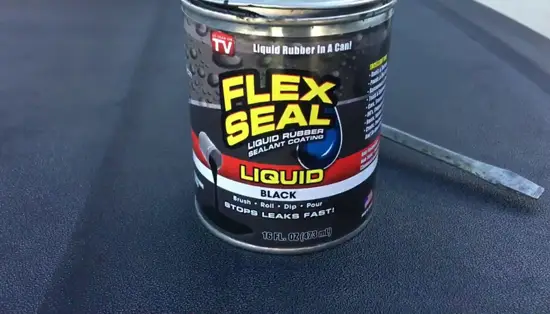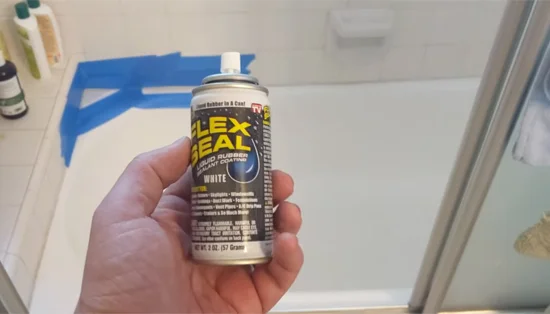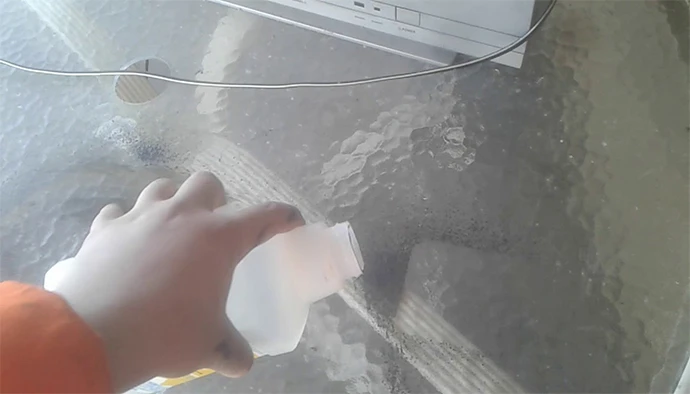Last Updated on January 1, 2023
Removing cured Flex Seal from concrete can be a tricky endeavor. The nature of Flex Seal’s adhesive properties combined with the porous and durable surface of concrete can make it difficult to remove without causing damage.
However, with the right techniques and tools, you can easily remove cured Flex Seal from concrete and restore its original appearance.
Before you start, make sure that you have the following items available: rubber gloves, a putty knife, a wire brush, mineral spirits, and soap and water.
This is important because these tools will help protect your hands from abrasive chemicals as well as helping to break down the adhesive properties of the cured Flex Seal on your concrete surface.
In this blog post, we’ll cover step-by-step guidelines to help you clean up your concrete surface of cured Flex Seal.
Methodology for Removing Flex Seal from Concrete

Step 1: Prepare the Work Area and Gather Necessary Materials
Before attempting to remove flex seals from concrete, it is important to properly prepare the work area. Start by making sure the concrete surface is clean and free of dirt, dust and debris.
Then, gather all the materials that you will need for removal including a non-abrasive scraper or scrubber, safety gear such as gloves and goggles, a cleaning agent such as dish soap, mineral spirits or vinegar solutions, a spray bottle or bucket and warm water.
Step 2: Put On Safety Gear and Scrape Off Excess Material
Once the work area has been prepared and all necessary materials have been gathered, put on safety gear such as gloves and goggles before proceeding with removal.
To start removing cured flex seals from concrete surfaces use a non-abrasive scraper or scrubber which will help minimize scratching on the surface of the concrete. Carefully scrape off excess material in order to improve cleaning effectiveness.
Step 3: Apply Cleaning Agent to Affected Area
The most effective agents for removing cured flex seals from concrete include dish soap, mineral spirits and vinegar solutions. Create a mixture of one part agent to three parts water in either a spray bottle or bucket. Spray onto affected areas where excess material has been removed or pour onto areas if using a bucket.
Allow this mixture to sit for 5-10 minutes for maximum penetration into the affected area followed by gently scrubbing with either a soft brush or sponge. After allowing another 5-10 minutes for cleaning effectiveness, rinse off with warm water before drying with a clean cloth or towel for best results.
Step 4: Agitate Mixture with Brush or Bristle Brush for Increased Effectiveness
For maximum results, use a stiff-bristled brush to vigorously agitate the mixture on the concrete surface. Be sure to press down firmly and scrub in a circular motion around the entire afflicted area.
This will help to lift any debris that is stuck to the surface of the concrete, making it easier to remove. Furthermore, this step can also help to break up any Flex Seal which may have cured more significantly, making it easier for further steps of cleaning.
Step 5: Rinse with Hot Water Source
To rinse away all traces of Flex Seal from the concrete surface, hot water is best used as it is able to soften and dissolve stubborn residues. For maximum results, using hot water from either a pressure washer or hose with an attachable spray nozzle is recommended.
As you are rinsing away any remaining residue, be sure to agitate it with a brush or bristle brush again so that all Flex Seal remnants can be fully removed from the concrete surface.
Using hot water also helps ensure that no dirt particles become embedded into the concrete after cleaning, thus preventing staining and discoloration over time.
Tools and Materials Needed
Safety Gear
Before beginning the process of removing a cured flex seal from concrete, it is important to wear protective gear such as safety glasses, gloves, and a dust mask.
This will protect you from any sharp edges that may be present when scraping off the surface material.
Scraper/Scrubber
A scraper or scrubber is required to remove the cured flex seal from the concrete surface. Depending on the type of surface being worked on, different types of scrapers may be needed (e.g., metal blades for hard surfaces).
It is important to use light pressure when scraping off the cured flex seal and not apply too much force which could damage the underlying surface material.
Cleaning Agent
Once the cured flex seal has been removed, a cleaning agent such as dish soap or mineral spirits should be applied to help further break down any residue left behind.
The cleaning agent should be mixed with hot water before being applied onto the affected area in order to get optimal results.
Hot Water Source
Hot water helps dissolve the residue left behind after removing cured flex seal from concrete surfaces more quickly than cold water would do so it’s important to have access to one while performing this task.
A bucket or power washer can both serve as an effective hot water source depending on your level of comfort working with these devices respectively.
Benefits of Removing Flex Seal From Concrete
There are several benefits associated with removing cured flex seal from concrete surfaces including improving overall aesthetics by restoring original color/texture; reducing likelihood of moisture damage due to presence of trapped liquid in porous materials; extending lifespan through regular maintenance; and ensuring proper adhesion for other coating materials like paint or stain since residue left behind can interfere with bonding process between two substances leading to peeling over time if not addressed properly early on in project life cycle.
Final Steps After Removal of Flex Seal from Concrete Surface
Once you have successfully removed the cured Flex Seal from the concrete surface, there are a few final steps to ensure that your project is complete and that it looks its best.
First, it is important to allow the concrete surface to dry completely before applying any new coating or paint. This will help to prevent the newly applied material from adhering improperly and cause it to flake off in the future.
If this step is not done, it could create an uneven finish on the concrete and make it look less than professional and attractive. You can accelerate this process by lightly drying off any excess moisture with a towel or absorbent cloth.
Second, you may want to consider sealing the newly cleaned concrete surface if desired. Sealing this type of surface helps protect against stains and can also add additional protection against water damage.
There are many types of sealers available on the market designed specifically for concrete surfaces, so be sure to do your research and find one that meets your needs and budget. Applying a sealer will also help enhance the appearance of your freshly cleaned space as well as improve its overall durability in terms of weather resistance.
Finally, it’s important to regularly inspect the area for any new residue buildup over time since more Flex Seal may naturally occur due to environmental conditions such as wind or rain carrying particles into the area.
To avoid having this issue reoccur in the future, try using window screening or other similar materials placed around entries such as doors or windows which can act as barriers against outside elements entering into your space and ensure that no debris can enter without first being filtered out.
Additionally, you may want to add some sort of chemical treatment such as a degreaser or degreasing detergent which can help keep surfaces clean between inspections while also helping keep odors at bay.
Is it necessary to use protective gear when removing cured Flex Seal from concrete?
Yes, it is necessary to use protective gear when removing cured Flex Seal from concrete. The protective gear should include safety goggles and a respirator mask to protect the eyes and lungs from exposure to fumes or dust that can be created during the removal process.
Additionally, rubber gloves should be worn to protect the hands from contact with any harsh chemicals used in the process.
How can you prevent damage to the concrete while removing Flex Seal?

Damage to the concrete can be prevented by using the correct tools for removal, including a scraper and putty knife. A heat gun may also be used but should be done with caution as too much heat can cause damage.
It is best to test this method on a small area first before applying it to larger areas of the surface. Additionally, an abrasive disk or brush may be used instead of scraping which will help remove any residue on the surface more easily without damaging the concrete.
How long does it typically take to remove cured Flex Seal from concrete?
How long it takes to remove cured Flex Seal from concrete typically depends on how thickly it has been applied and how much time has passed since its application.
Generally speaking, it could take anywhere from several minutes up to several hours depending on factors such as temperature and humidity as well as how many layers have been applied.
Does the temperature of the surface affect the removal process in any way?
The temperature of the surface can affect how quickly or easily cured Flex Seal will come off of concrete. If it is too cold then it may become harder and more difficult to scrape off while if it is too hot then there is an increased risk of damaging the concrete due to heat produced during scraping or by using a heat gun at high temperatures.
It is best to work in cooler temperatures where possible (below 80 degrees Fahrenheit) for optimal results when removing cured Flex Seal from concrete surfaces.
Conclusion
It is not necessary to remove cured Flex Seal from your concrete surfaces if you do it properly. By following the guidelines outlined and discussed in this blog post, cured Flex Seal can easily be cleaned from any surface.
Through careful preparation of the workspace area and gathering all necessary materials before proceeding with cleaning work, anyone can safely and effectively eliminate unwanted residue from their concrete surfaces without causing further damage or harm.
After successfully eliminating all buildup residue on affected areas, consider sealing newly cleaned surfaces in order to protect them against future buildup or contaminations. With these tips and tricks in mind, you should no longer worry about how to get rid of stubborn cured flex seal on your concrete floors or walls!


